How to clean an enamel bath?
One of the most common questions I get asked by my customers is what to use to clean an enamel bath?
I’ll answer this question later but first, let’s focus on the reason why your bath is getting hard to clean and what you can do to avoid problems?
Why your bath became difficult to keep clean? The types of bathtubs.
In general, there are two types of bathtubs – enamel coated (cast iron and pressed steel) and acrylic made (fibre glass, stone resin bath included). It is important to point out the difference, so you will know how to treat it and what is safe to use for each type.
The first group of a topcoat (for iron and steel) is a glass-like material (vitreous enamel), second is a plastic (acrylic).
Each has different chemical resistance, and both finishes can be more or less delicate and immune to abrasion.
Same as cast-iron models, a pressed steel bath is coated with vitreous enamel. Resistant to impact but not to all chemicals…
What is the recommended product to use?
Bath resurfacing in progress – deep cleaning and de-glossing the enamel surface. Some heavy domestic cleaners can etch your bath or porcelain sink – the last thing you wish for.
As a rule of thumb, I don’t recommend any powder or cream cleaners, for a reason as above – it can scratch your bath finish. It may not happen after a single time use, but I’ve seen baths became dull after constant use of powder cleaners.
It’s not good for any type of finish to use non-liquid products, including renewed baths.
Hawk Research Labs study – Cleaner Compatibility Test.
The manufacturer of the bath resurfacing system I use for my work published the results of how the coating performs after a long time of usage. It was made as a laboratory-controlled experiment. To answer how the powder cleaners affect the finish on the resurfaced bath, please see the results for Glastech™ Lo 9000 Series topcoat and the product called Comet. The results for topcoat shine when using a powder has changed after 2000x rubs (approx. five years time normal use). All the other cleaners used for the test (non-powders) do not affect a thickness or a finish appearance.
The results are published here:
Soapscum, cleaner residue and scale…
Another reason to not use cream cleaners is that it may build up as a residue. Restored bath is most likely the easiest to clean – if done properly the finish is extremely smooth and so will least likely to catch the dirt and build up a scale. The cream cleaners will not only make the surface dull (abraded) but also can be a reason for surface discolouration.
Cleaning prior tiles resurfacing. Years of dust and dirt building up means a lot of preparation.
A stained bath cause.
Baths get stained either by using aggressive chemicals, cream cleaners as mentioned above, but also it can be a water mark or serious water caused damage. If your bath is not leveled properly or you have a leaking tap it most likely leads to an expensive repair to enamel and resurfaced tub. Standing water can destroy the bottom of your restored and original vitreous-enamel one. Make sure that your bath is leveled and you don’t have a leaking tap (standing water as a result of a leak, can also cause rust around the waste area!).
An extreme example of water leaking damage to the enamel.
Anti slip mat – take it out!
Enamel is rough, bath because of its porosity is unpleasant to use and look dirty. The next photo is after the resurfacing by Eager Beaver.
If you use an antislip rug or mat, take it out after use (especially for re-enamelled one) and wash it from time to time. It is easy to trap the water under a shower mat and if left for long enough, it is a perfect place for bacteria and mould. A non-slip rug can shorten the life of enamel and it’s a no-no for restored surfaces (avoid those with suction cups). I offer an anti-slip application that is a permanent part of a surface. It can be added anytime and also to not yet resurfaced bathtubs and shower trays.
As good as new in a few hours time. The least disruptive method, cost-effective and environmentally friendly. Half a bag of dry rubbish and about 6 hrs later to see this bath as new again. What is the cost of replacing a structurally good bath?
The enamel chemical resistance. Why not to use a bleach contained cleaners?
The hardest to keep in a good appearance are the bathtubs with worn enamel. Why is the gloss finish getting porous and hard to clean? Usually, the bottom part of the enamel coated bath is affected. If it’s not by dirt, scale or abrasion, the common reason why the surface was damaged (etched) are modern chemicals, contained bleach. Aggressive cleaners, can permanently affect the smoothness and gloss of the vitreous enamelled bath and causing the surface to not only become hard to clean but also unpleasant to use (and sit in it ;) ).
If that happens, there’s no way to rescue a bath in another way than resurfacing. Even if you have a chance to clean the etched tub, it will catch the dirt again after a while. Often to get the clean look on a damaged vitreous enamelled bath, more bleach is used causing a short term better results, and a longer-term disaster. Bleach causes the bath to be full of grooves, eating the top layer of the enamel surface, creating craters where unevenly poured and left for long enough to cause it.
Opposite to enamel, an acrylic bath is usually more resistant to modern type cleaners and bleach. But also easy to stain (hair dye, oils) and if treated with improper cleaner can even lead to cracks in a topcoat or cause the surface to melt or soften it as a result of a chemical reaction.
Resurfaced (re-enamelled) baths are the most chemical resistant.
The hardest to keep in a good appearance are the bathtubs with worn enamel. Why is the gloss finish getting porous and hard to clean? Usually, the bottom part of the enamel coated bath is affected. If it’s not by dirt, scale or abrasion, the common reason why the surface was damaged (etched) are modern chemicals, contained bleach. Aggressive cleaners, can permanently affect the smoothness and gloss of the vitreous enamelled bath and causing the surface to not only become hard to clean but also unpleasant to use (and sit in it ;) ).
If that happens, there’s no way to rescue a bath in another way than resurfacing. Even if you have a chance to clean the etched tub, it will catch the dirt again after a while. Often to get the clean look on a damaged vitreous enamelled bath, more bleach is used causing a short term better results, and a longer-term disaster. Bleach causes the bath to be full of grooves, eating the top layer of the enamel surface, creating craters where unevenly poured and left for long enough to cause it.
Opposite to enamel, an acrylic bath is usually more resistant to modern type cleaners and bleach. But also easy to stain (hair dye, oils) and if treated with improper cleaner can even lead to cracks in a topcoat or cause the surface to melt or soften it as a result of a chemical reaction.
Resurfaced (re-enamelled) baths are the most chemical resistant.
Worn enamel is a nightmare to clean. If you have such a problem – don’t waste your time cleaning it, contact me to restore it.
Finally, what are the recommended cleaners and methods to clean an enamel bath?
I’ll keep saying the same over again – don’t scrub it. No matter what it is made of, use a mild domestic cleaner or a bathroom cleaner that is a proper liquid one and does not contain bleach!
My personal choice is an Ecover bathroom cleaner, it’s effective, natural and has good reviews.
Remember that if the standard cleaners fail, you can always drop me a line and I’ll give you a personal answer or recommend a service to fix your bath problem. Thank you for reading.
How to clean an enamel bath with natural products?
These are not my recipes, but are very effective and from natural ingredients. I’ve been given it by one of my clients and she is making her own cleaners to minimize plastic usage. Comment below, if you had used it and what do you think about it?
Bath cleaner – multi-purpose cleaner
1/4 cup white vinegar
1 tablespoon of baking soda (soda bicarbonate)
1 litre hot water
1/2 lemon
* add oil essences if required
Toilet cleaner
3/4 cup white vinegar
3/4 cup of soda bicarbonate (baking soda)
10 drops tea tree oil
10 drops lavender oil
Glass cleaner
1/4 cup white vinegar
1 tablespoon corn starch (corn flour)
2 cups warm water
* add oil essences if required


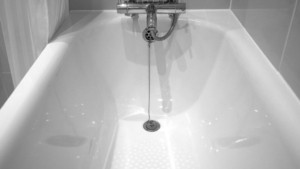
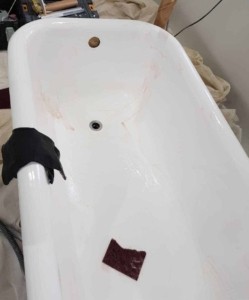
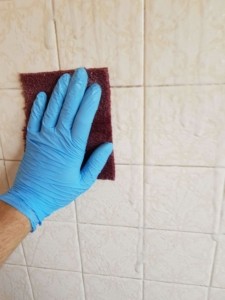
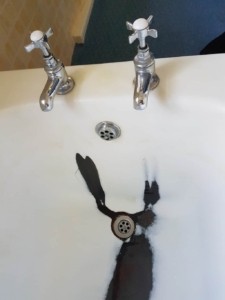
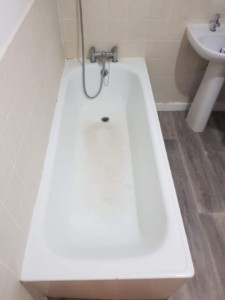
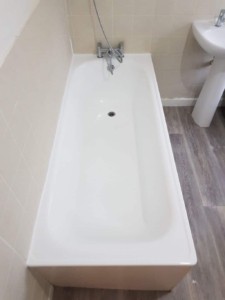
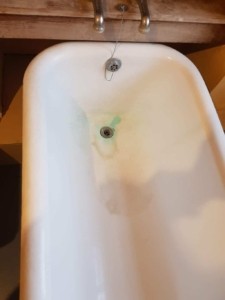


Thank you for sharing… Natural would really be great. Especially when you have little ones in your home.
Your comment motivated me to update the article with natural ingredients cleaners recipies. Best Regards, Tomasz.
I have an enamel bath in a cottage near Budleigh Salterton. It has lost its finish through over zealous scrubbing with bleach etc and constantly looks grubby. I’m selling the cottage and would like the bath to be restored/polished before it goes to market – i.e. over the next fortnight. Can you help?
yes James, I can reach you and offer help. I’ll send you an email. Kindest Regards, Tomasz.
If you use a steel scourer on the bath and it is mat can it leak
You will not cause a leak this way for sure, but I don’t recommend to use a steel wool or scourer, Linda. It can scratch the surface, leaving you with a places that are dull and difficult to clean. If the enamel on the bath is already dull and coarse, it catches the dirt easier. Abrading it will temporarily help but the bath needs resurfacing.